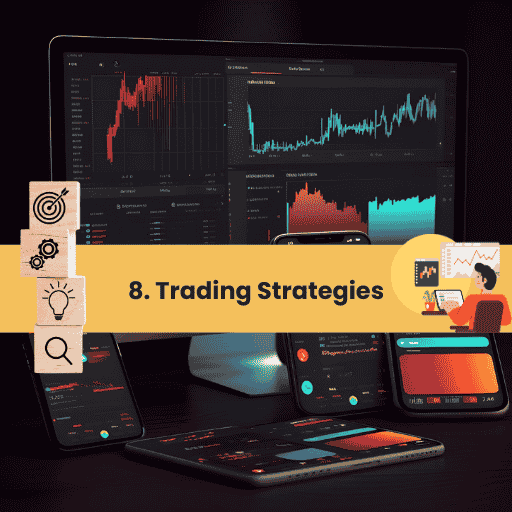Are you tired of watching your investments stagnate while others seem to effortlessly grow their wealth through trading? 🤔 The world of financial markets can be both thrilling and daunting, especially for those just starting their trading journey. But what if you could unlock the secrets of successful traders and transform your financial future?
Welcome to the exciting realm of Trading Strategies! Whether you’re a novice investor or a seasoned trader looking to refine your skills, understanding the various approaches to trading is crucial for success in today’s dynamic markets. From technical analysis to psychological aspects of trading, this blog post will demystify the essential components that make up effective trading strategies.
In the following sections, we’ll explore six key areas that form the foundation of successful trading. We’ll begin by delving into different trading styles, move on to technical and fundamental analysis techniques, discuss the importance of risk management, and even touch on the psychological factors that can make or break a trader. Finally, we’ll introduce you to some advanced strategies that could take your trading game to the next level. So, buckle up and get ready to embark on a journey that could revolutionize your approach to the financial markets! 💼📊

Understanding Different Trading Styles
In the world of financial markets, traders employ various strategies to capitalize on price movements and generate profits. Let’s explore four distinct trading styles, each with its own unique approach and time horizon.
A. Day Trading: Capitalizing on Short-Term Price Movements
Day trading involves executing multiple trades within a single trading day, with all positions closed before the market closes. This fast-paced style requires quick decision-making and a keen eye for short-term price fluctuations.
Key characteristics of day trading:
- Rapid execution of trades
- Utilization of intraday charts and technical indicators
- High focus on market volatility
- Minimal exposure to overnight risk
Day traders often use technical analysis tools such as:
| Tool | Purpose |
|---|---|
| Moving Averages | Identify trend direction |
| Relative Strength Index (RSI) | Spot overbought or oversold conditions |
| Volume Analysis | Confirm price movements |
| Support and Resistance Levels | Determine entry and exit points |
B. Swing Trading: Profiting from Medium-Term Trends
Swing trading aims to capture gains from price movements over several days to weeks. This style allows traders to take advantage of longer-term trends while avoiding the stress of constant market monitoring.
Advantages of swing trading:
- Less time-intensive than day trading
- Potential for larger profits per trade
- Ability to use both technical and fundamental analysis
- Suitable for those with full-time jobs
C. Position Trading: Leveraging Long-Term Market Shifts
Position trading involves holding trades for extended periods, often months or even years. This style focuses on identifying and capitalizing on major market trends and fundamental shifts in asset valuations.
Position traders typically:
- Rely heavily on fundamental analysis
- Use weekly or monthly charts for technical analysis
- Have a higher tolerance for short-term market fluctuations
- Aim for substantial gains over time
D. Scalping: Exploiting Tiny Price Fluctuations
Scalping is an ultra-short-term trading style that aims to profit from minimal price changes, often holding positions for mere seconds or minutes. This high-frequency approach requires intense focus and quick reflexes.
Scalping techniques include:
- Bid-ask spread trading
- Momentum trading on news events
- Order flow analysis
- High-frequency algorithmic trading
Now that we’ve explored these different trading styles, it’s important to understand that each approach has its own set of risks and rewards. Traders must choose a style that aligns with their personality, time commitment, and financial goals. In the next section, we’ll delve into the technical analysis techniques that can enhance your chosen trading strategy.

Technical Analysis Techniques
Chart Patterns: Identifying Profitable Setups
Chart patterns are visual representations of price movements that can help traders predict future market behavior. Some common patterns include:
- Head and Shoulders
- Double Top/Bottom
- Triangle Patterns (Ascending, Descending, Symmetrical)
- Flag and Pennant
To effectively use chart patterns, traders should:
- Practice pattern recognition
- Confirm patterns with other indicators
- Consider the overall market context
Indicators: Using Mathematical Tools for Decision-Making
Technical indicators are mathematical calculations based on price, volume, or open interest. They provide additional insights into market trends and potential reversals. Popular indicators include:
| Indicator | Type | Purpose |
|---|---|---|
| Moving Averages | Trend | Identify overall direction |
| RSI | Momentum | Measure overbought/oversold conditions |
| MACD | Trend/Momentum | Identify trend changes and momentum |
| Bollinger Bands | Volatility | Measure price volatility and potential reversals |
Candlestick Analysis: Reading Price Action Signals
Candlestick charts offer a wealth of information about price action. Key candlestick patterns to watch for include:
- Doji
- Hammer and Hanging Man
- Engulfing Patterns
- Morning and Evening Stars
These patterns can signal potential trend reversals or continuations when interpreted correctly.
Support and Resistance: Defining Key Price Levels
Support and resistance levels are critical in technical analysis. They represent price points where:
- Support: Buying pressure is expected to overcome selling pressure
- Resistance: Selling pressure is expected to overcome buying pressure
Traders use these levels to:
- Identify potential entry and exit points
- Set stop-loss orders
- Determine price targets
Trend Lines: Spotting Market Direction
Trend lines are simple yet powerful tools for visualizing market direction. They connect a series of highs or lows to show:
- Uptrends: Higher lows
- Downtrends: Lower highs
- Sideways trends: Horizontal lines
Traders use trend lines to:
- Confirm the overall market direction
- Identify potential breakout or breakdown points
- Spot trend reversals
By combining these technical analysis techniques, traders can develop a comprehensive approach to market analysis. However, it’s important to remember that no single technique is foolproof. Successful traders often use a combination of methods and continuously refine their strategies based on market conditions and personal experience.
Now that we’ve covered the essential technical analysis techniques, let’s explore how fundamental analysis can complement these strategies to provide a more holistic view of the market.

Fundamental Analysis Approaches
As we delve into fundamental analysis approaches, we’ll explore how traders use various economic and financial data to make informed decisions. This method of analysis is crucial for understanding the intrinsic value of securities and predicting long-term market trends.
A. Economic Indicators: Gauging Market Health
Economic indicators are vital tools for assessing the overall health of an economy and its potential impact on financial markets. These indicators provide insights into various aspects of economic performance, helping traders anticipate market movements.
Key economic indicators include:
- Gross Domestic Product (GDP)
- Unemployment Rate
- Consumer Price Index (CPI)
- Interest Rates
- Manufacturing Index
| Indicator | What It Measures | Impact on Markets |
|---|---|---|
| GDP | Overall economic output | Higher GDP often leads to bullish markets |
| Unemployment Rate | Job market health | Lower rates typically boost consumer spending |
| CPI | Inflation levels | High inflation may lead to interest rate hikes |
| Interest Rates | Cost of borrowing | Lower rates tend to stimulate economic growth |
| Manufacturing Index | Industrial sector health | Higher index suggests economic expansion |
B. Company Financials: Evaluating Stock Potential
Analyzing company financials is crucial for assessing the potential of individual stocks. Traders examine various financial statements and ratios to gauge a company’s financial health and growth prospects.
Key financial metrics to consider:
- Revenue and Earnings Growth
- Price-to-Earnings (P/E) Ratio
- Debt-to-Equity Ratio
- Return on Equity (ROE)
- Free Cash Flow
C. Industry Analysis: Assessing Sector Trends
Understanding industry dynamics is essential for placing individual companies in context and identifying sector-wide trends. Traders analyze factors such as:
- Market size and growth rate
- Competitive landscape
- Regulatory environment
- Technological disruptions
- Consumer behavior shifts
By evaluating these factors, traders can better understand how industry trends may affect individual stocks and make more informed investment decisions.
D. News and Events: Anticipating Market Reactions
News and events can have significant impacts on market sentiment and stock prices. Traders who effectively incorporate news analysis into their fundamental approach can gain a competitive edge.
Important news categories to monitor:
- Corporate announcements (earnings reports, mergers, acquisitions)
- Geopolitical events
- Policy changes and regulatory updates
- Natural disasters and global crises
- Technological breakthroughs
By staying informed about relevant news and events, traders can anticipate potential market reactions and adjust their strategies accordingly.
With a solid understanding of fundamental analysis approaches, we can now explore the critical aspect of risk management in trading, which is essential for long-term success in the financial markets.

Risk Management Essentials
Now that we’ve covered the fundamentals of technical and fundamental analysis, let’s dive into one of the most crucial aspects of trading: risk management. Proper risk management is the foundation of successful trading, helping you protect your capital and ensure long-term profitability.
A. Position Sizing: Protecting Your Capital
Position sizing is a critical component of risk management in trading. It involves determining how much of your capital to allocate to each trade. By carefully managing your position sizes, you can protect your trading account from significant losses and maintain a sustainable trading career.
Here are some key principles of effective position sizing:
- Never risk more than 1-2% of your total trading capital on a single trade
- Adjust position sizes based on market volatility
- Consider your win rate and risk-reward ratio when determining position sizes
- Use a position size calculator to ensure consistency
B. Stop-Loss Orders: Limiting Potential Losses
Stop-loss orders are essential tools for managing risk in trading. They automatically close your position when the price reaches a predetermined level, helping you limit potential losses and protect your profits.
| Type of Stop-Loss | Description | Best Used For |
|---|---|---|
| Fixed Stop-Loss | Set at a specific price level | Traders with a clear exit strategy |
| Trailing Stop-Loss | Moves with the price in your favor | Capturing profits in trending markets |
| Time-Based Stop-Loss | Closes the trade after a set time period | Day traders and short-term strategies |
C. Risk-Reward Ratios: Ensuring Profitable Trades
A risk-reward ratio compares the potential loss of a trade to its potential profit. By maintaining a favorable risk-reward ratio, you can ensure that your winning trades more than compensate for your losing ones.
Consider the following guidelines:
- Aim for a minimum risk-reward ratio of 1:2
- Adjust your ratio based on your trading style and market conditions
- Use risk-reward ratios in conjunction with your win rate to determine overall profitability
D. Diversification: Spreading Risk Across Assets
Diversification is a key risk management strategy that involves spreading your investments across different assets, markets, or trading strategies. This approach helps to reduce the impact of poor performance in any single area of your portfolio.
Effective diversification strategies include:
- Trading multiple asset classes (e.g., stocks, forex, commodities)
- Balancing long and short positions
- Implementing various trading timeframes
- Using a mix of technical and fundamental analysis
By incorporating these risk management essentials into your trading strategy, you’ll be better equipped to handle market volatility and preserve your capital. Remember, successful trading is not just about making profits, but also about minimizing losses and managing risk effectively.
Next, we’ll explore the psychological aspects of trading, which play a crucial role in implementing these risk management techniques consistently.

Psychological Aspects of Trading
Now that we’ve covered the technical and fundamental aspects of trading, let’s delve into the crucial psychological factors that can make or break a trader’s success. The mental game of trading is often overlooked but plays a pivotal role in long-term profitability.
A. Emotional Control: Maintaining Objectivity
Maintaining emotional control is paramount in trading. The markets can be a rollercoaster of emotions, but successful traders learn to detach themselves from these ups and downs. Here are some techniques to help maintain objectivity:
- Mindfulness meditation
- Journaling trading experiences
- Setting predetermined entry and exit points
- Utilizing stop-loss orders
Implementing these practices can help traders make rational decisions based on analysis rather than fear or greed.
B. Discipline: Sticking to Your Trading Plan
A well-crafted trading plan is useless if not followed consistently. Discipline is the bridge between goals and accomplishment in trading. Consider the following elements when developing and sticking to your plan:
| Plan Element | Description | Importance |
|---|---|---|
| Entry Rules | Specific conditions for entering a trade | Prevents impulsive trades |
| Exit Rules | Predetermined profit targets and stop-loss levels | Manages risk and locks in profits |
| Position Sizing | Amount of capital risked per trade | Ensures longevity in the market |
| Risk Management | Maximum daily/weekly loss limits | Protects overall trading capital |
C. Patience: Waiting for High-Probability Setups
In trading, patience truly is a virtue. The ability to wait for high-probability setups rather than forcing trades can significantly impact profitability. Here’s how to cultivate patience:
- Develop a clear set of criteria for ideal trade setups
- Practice observing the market without trading
- Engage in other activities to avoid the temptation of overtrading
- Review missed opportunities objectively to reinforce patience
Remember, it’s not about the quantity of trades, but the quality of each trade executed.
D. Continuous Learning: Adapting to Market Changes
The trading landscape is constantly evolving, and successful traders commit to lifelong learning. Staying adaptable and open to new strategies is crucial for long-term success. Consider these approaches to continuous learning:
- Regularly review and analyze past trades
- Stay updated with financial news and market trends
- Attend trading seminars and workshops
- Participate in trading communities for peer learning
- Experiment with paper trading to test new strategies
By embracing a growth mindset and consistently refining your skills, you’ll be better equipped to navigate the ever-changing markets.
Next, we’ll explore advanced trading strategies that build upon these psychological foundations, allowing you to take your trading to the next level.
Advanced Trading Strategies
As we delve deeper into the world of trading, it’s time to explore some advanced strategies that can take your trading game to the next level. These sophisticated approaches require a solid understanding of market dynamics and often involve more complex analysis and execution.
A. Pairs Trading: Exploiting Correlated Assets
Pairs trading is a market-neutral strategy that involves simultaneously buying and selling two highly correlated securities. This approach aims to profit from the relative price movements between the two assets, regardless of overall market direction.
Key Components of Pairs Trading:
- Identifying correlated pairs
- Calculating spread and z-score
- Determining entry and exit points
- Managing risk through position sizing
| Advantages | Challenges |
|---|---|
| Market-neutral | Requires continuous monitoring |
| Lower risk | Correlation breakdown risk |
| Potential for consistent returns | Higher transaction costs |
B. Options Strategies: Leveraging Derivatives
Options provide traders with versatile tools to create complex strategies that can profit from various market conditions. These strategies often involve combining different options contracts to achieve specific risk-reward profiles.
Popular options strategies include:
- Covered Calls
- Iron Condors
- Butterfly Spreads
- Straddles and Strangles
C. Momentum Trading: Riding Strong Market Moves
Momentum trading capitalizes on the tendency of strong price movements to continue in the same direction. This strategy involves identifying assets with significant price momentum and entering positions in the direction of the trend.
Key factors in momentum trading:
- Trend identification
- Volume analysis
- Relative strength comparison
- Exit strategy and profit-taking
D. Mean Reversion: Profiting from Price Normalization
Mean reversion strategies are based on the principle that asset prices tend to return to their average levels over time. Traders using this approach look for temporary deviations from the mean and bet on the price returning to its historical average.
Mean Reversion Techniques:
- Bollinger Bands trading
- Oversold/Overbought indicators
- Statistical arbitrage
- Moving average convergence/divergence (MACD)
E. Arbitrage: Capitalizing on Price Discrepancies
Arbitrage involves simultaneously buying and selling the same or similar financial instruments in different markets to profit from price discrepancies. This strategy requires quick execution and often relies on advanced technology to identify and exploit fleeting opportunities.
| Arbitrage Type | Description |
|---|---|
| Statistical Arbitrage | Exploits pricing inefficiencies using statistical models |
| Triangular Arbitrage | Involves three different currencies or assets |
| Merger Arbitrage | Profits from price differences during corporate mergers |
| Index Arbitrage | Exploits discrepancies between index futures and underlying stocks |
These advanced trading strategies offer sophisticated ways to approach the market, potentially enhancing returns and managing risk. However, they also come with increased complexity and often require more capital, advanced analytical skills, and robust risk management practices. As we move forward, it’s crucial to remember that mastering these strategies takes time, practice, and continuous learning.

Mastering the art of trading requires a comprehensive understanding of various strategies, analysis techniques, and risk management principles. By exploring different trading styles, honing your technical and fundamental analysis skills, and implementing robust risk management practices, you can significantly enhance your trading performance. Additionally, recognizing the psychological aspects of trading and developing emotional discipline are crucial for long-term success in the financial markets.
As you continue your trading journey, remember that success doesn’t come overnight. Consistently apply the knowledge gained from this guide, stay informed about market trends, and continuously refine your strategies. Whether you’re a novice trader or an experienced professional, there’s always room for improvement. Take the time to practice, learn from your mistakes, and adapt your approach as market conditions evolve. With dedication and perseverance, you can develop a trading strategy that aligns with your goals and helps you navigate the complex world of financial markets.


